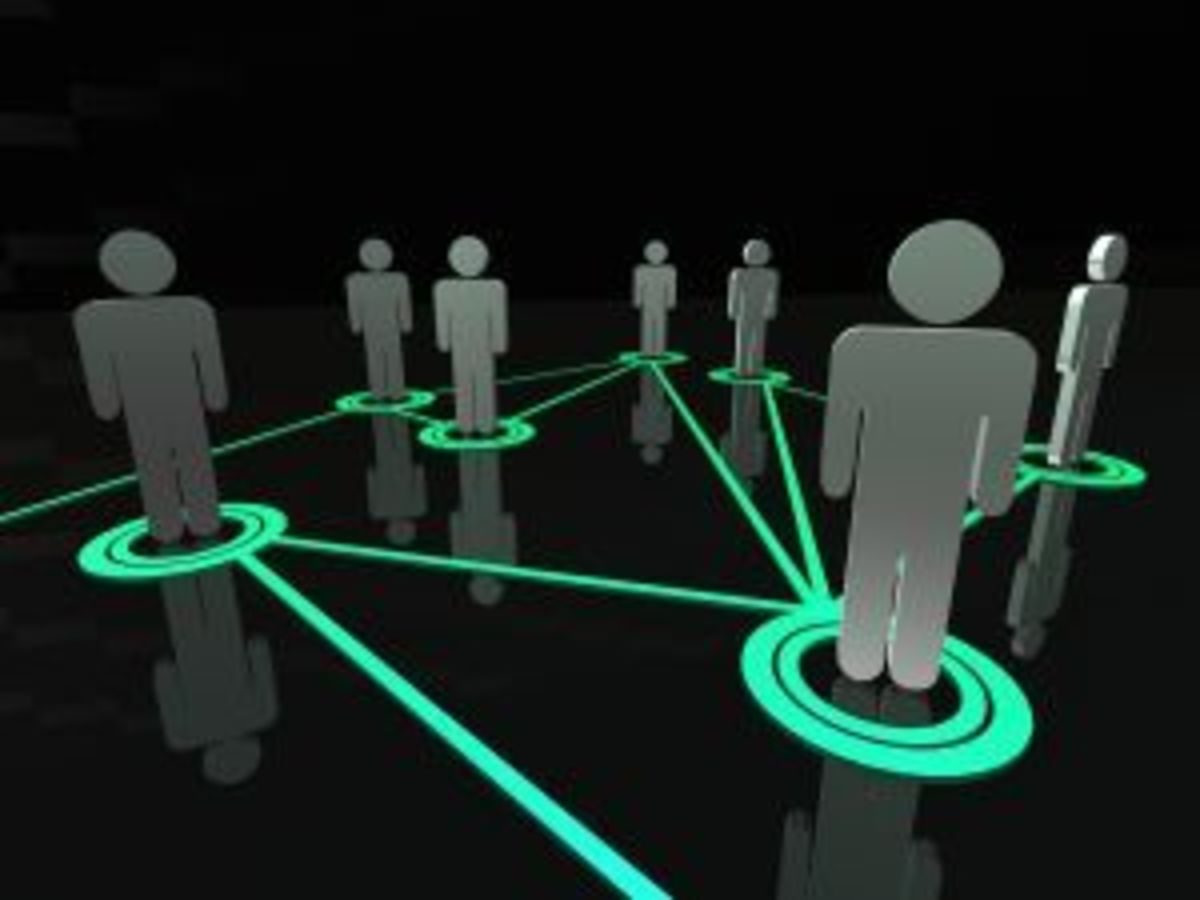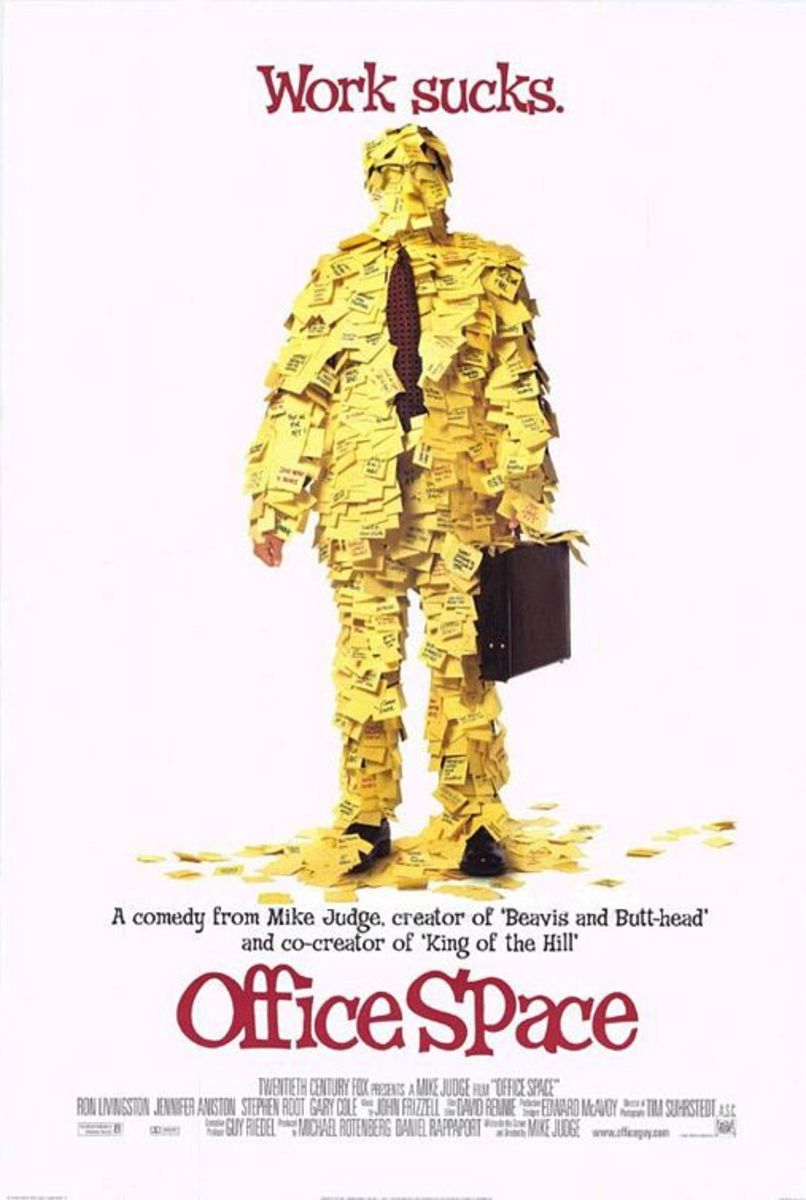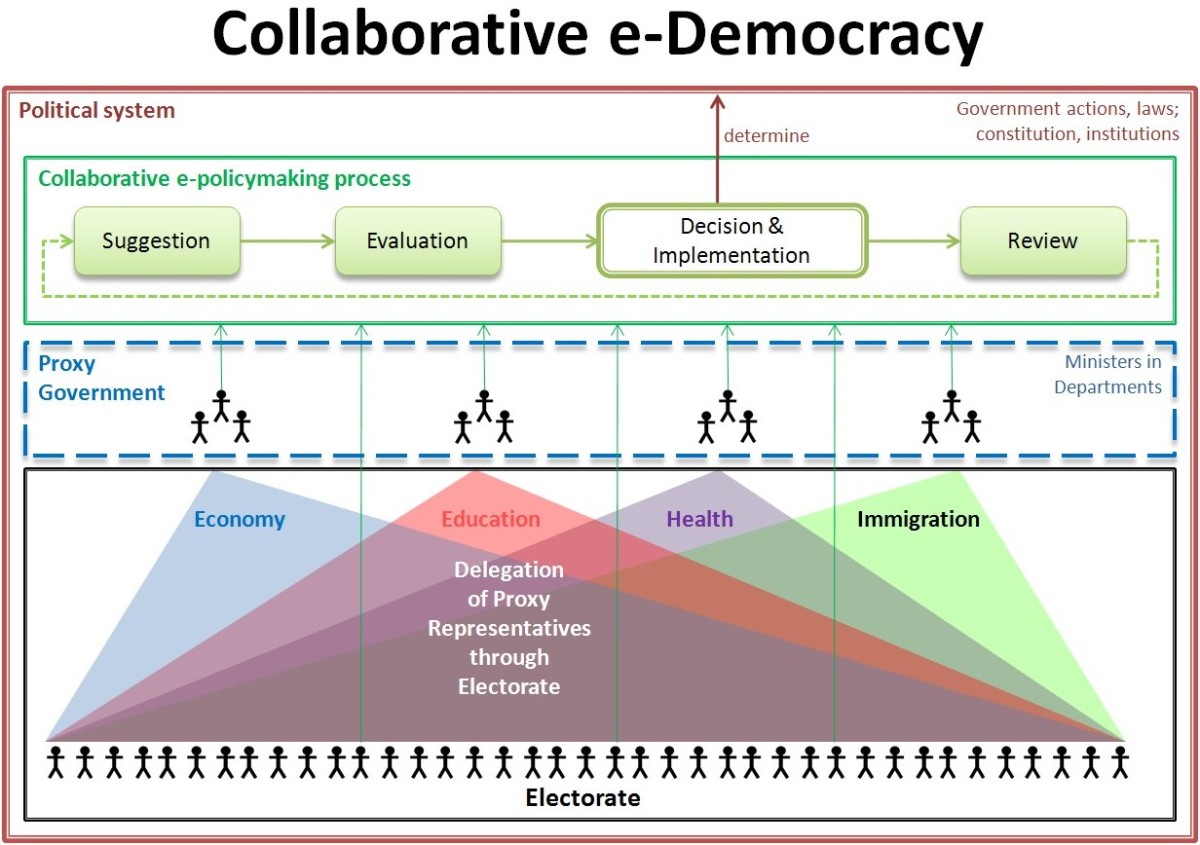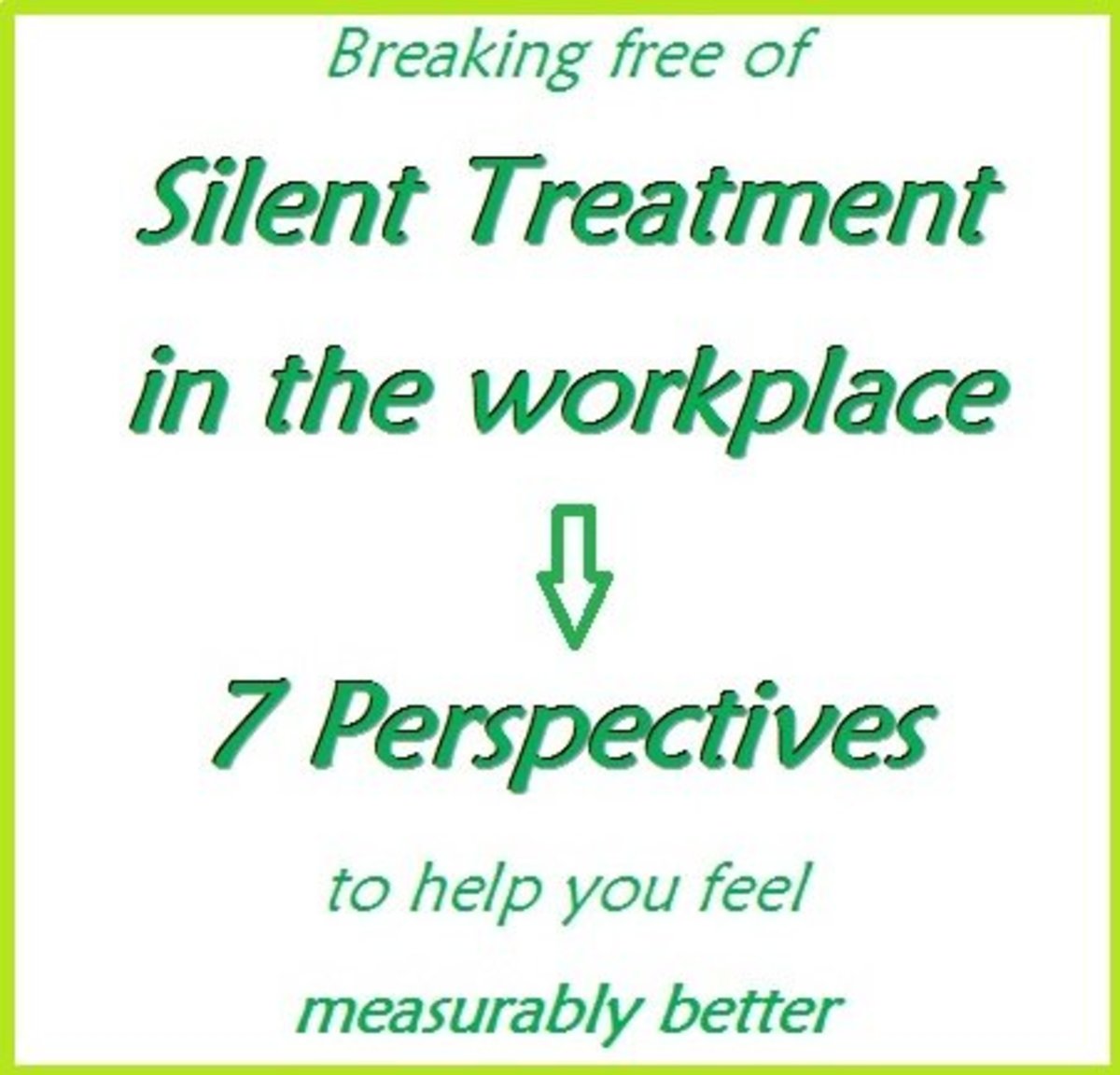Workplace Diversity The Art of Positive Disagreement
Workplace Diversity: The Art of Positive Disagreement©
Mark Monroe
April 19, 2011
Introduction
This paper is going to discuss how successful diversity management from an organizational point of view is the art of learning how to manage disagreement so that it becomes a positive influence within an organization. This line of thinking by itself may seem a little out of phase with popular management theories that are looking for harmony or at least the appearance of a cohesive working team. Thus, to say that organizations would want to have or foster an environment that promotes disagreement amongst their workforce may seem a little odd. This is due to the bad reputation disagreement has in the business world. Disagreement is often associated with disruption, disrespect, disobedience, disloyalty, and dissension, and rightly so, if disagreement is mismanaged it can lead to all of those things. The point is that it does not necessarily have to, and indeed it can have beneficial consequences. By disagreement I mean points of tension that manifest in the workplace. They take the form of employees engaging in verbal confrontation with each other, or challenging established practices within the work environment. Employees in this situation are often labeled as troublemakers and deemed to not fit in with the organization standards and may be forced to leave. How well an organization manages disagreement is a key measure of an organization’s success with diversity management. To lead and develop people who are in constant agreement with each other means that you are not leading a truly diverse organization, but rather you are in charge of a homogeneous organization with different colored[1] faces. An important fact companies must understand is that diversity spawns disagreement, but it is not just that disagreement is something you have to put up with in a diverse organization—it is valuable in and of itself.
“If everyone is thinking alike, then somebody isn't thinking[2].” This quote by General George Patton highlights the real value that diversity brings to an organization--diversity of thought. This is not to say that like-minded people cannot be successful, because there are examples of organizations that have achieved some level of financial success with a homogeneous workforce; but I will challenge anyone to find an organization (this applies to business, religious, political, educational, or social/economic system) that is or has been able to sustain its success without introducing new ideas or processes. A forced homogenous groupthink tends to stagnate and over time will fail. I use the expression "forced homogeneous groupthink" because the only way to truly have a homogenous groupthink is by oppressive force.
True progress within an organization happens when the organization is able to effectively tap into the different points of knowledge that their employee base and surrounding community have to offer. This progress is not simply ideological, but is characterized by the successful achievement of the organizational mission. Organizations that have been able to tap into this knowledge have been sustained.
Figure 1
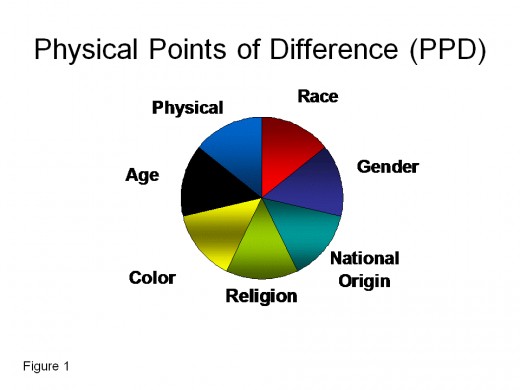
Two-Dimensional Model of Diversity
To understand the relationship between diversity, disagreement, and management we first have to understand how people view diversity or points of difference. Organizations first have to acknowledge the points of difference before disagreement can be a productive influence within the organization. When most people think of diversity they usually limit themselves to the concept of physical diversity. This one-dimensional view of diversity does not represent its complexities. It is important to stress this one-dimensional view is something that many segments of the workforce will never progress past. It is my contention that successful organizations must move beyond understanding diversity merely through the lens of physical difference. The way organizations should think about diversity is through a two-dimensional model.
The first dimension is (Figure 1) Physical Points of Difference (PPD), which deals only with the physical plane of human existence. Physical diversity consists of gender (to include sexuality), race, color, national origin (to include language), physical limitations, age, and certain aspects of religious beliefs (i.e. dress, action, and religious facilities). If you are familiar with United States employment law, you will recognize the seven parts of PPD as the seven protected categories generally associated with federal employment law. The Civil Rights Act of 1964 and other laws against discrimination are focused on PPD awareness.
As stated earlier, getting beyond physical differences is only the first step and, relatively speaking, it is the easier of the two dimensions to comprehend. The challenge of acceptance increases when you mix physical difference(s) with a difference of thought processes.
Figure 2
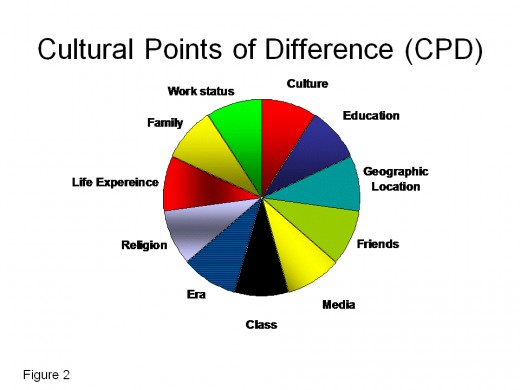
When you start to accept or at least acknowledge the existence of diversity of thought, you are now entering the second dimension that is an awareness of (Figure 2) Cultural Point of Difference (CPD). If PPD deals with the physical aspects of diversity, then CPD deals with the non-physical dimensions of diversity or creation of ‘diversity of thought’. The difference between the two dimensions is that physical diversity is made up of characteristics like, race, gender, and physical capabilities. The non-physical dimension of diversity focuses on influencers.
The influencers are a web of factors that shape how an individual interacts with and views the world. Influencers can include but are not limited to religion, educational level, where you went to school, friends, family, geographic location and era. Not all the influencers will have the same effect on all individuals. Hence, you can take two people with the same PPD characteristics but have a very different world outlook based on the CPD influencers. That is one reason why stereotyping based on PDD alone causes so much trouble; it is making assumptions about a person based on incomplete information.
Figure 3
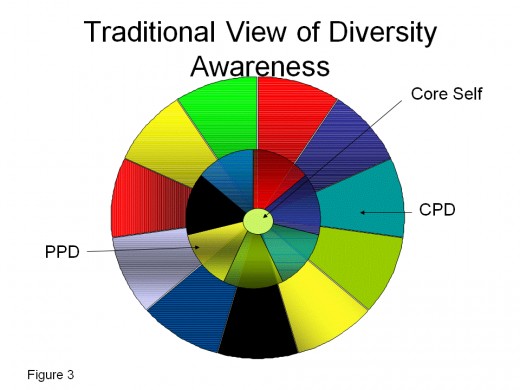
Diversity consultants traditionally represent these two dimensions of diversity by using a model (Figure 3) that is a circle within circle. The CPD dimensions are the outer circle while the PPD characteristics are the inner circle that is closer to the core being. This works well for an internal or first person perspective of one's own diversity, but it fails to explain how the external world views an individual. While an individual may be made up of the two circles one within the other, the influencers cause tension that change the relationship of the circles for the individual. The model from the external view looks more like two overlapping ovals (Figure 4). At first, this distinction from the traditional may appear to be fairly simple. Think about how people interact with the world through sensory perception. Our first impression of anything or anyone is on the PPD plane of existence. In the real world when people are dealing with people different from seeing them solely through a PPD lens to understanding them at the CPD dimension.
For linear thinkers, a word of caution, there is no clear dividing line between the two dimensions. Nor is there a standard length of time a person will stay in one dimension or what events will trigger a person to move between the two dimensions. Organizationally moving too quickly from PPD to CPD understanding can have the effect of watering down the issues and the effort until they are meaningless. This phenomenon results in the majority of the organization will not be able to understand the underlying issues that affect diversity interaction. Some people (and many organizations) may be reluctant to make the move beyond an understanding of PPD. The unknown factors associated with CPD become a barrier. Many organizations understand and accept that they have a legal obligation to deal with physical diversity within the organization, but they do not want to deal with the less definable aspect of a person’s thought processes. Because of this hesitation, organizations can pay a heavy price in productivity or in the worst cases internal discord. Moving into the CPD area of diversity awareness represents more changes the organization has to adapt to. If the organization refuses to make this move, they are in fact saying, “We want people who look different but think the same.” This focusing on just physical diversity adds little or no value to an organization.
Figure 4
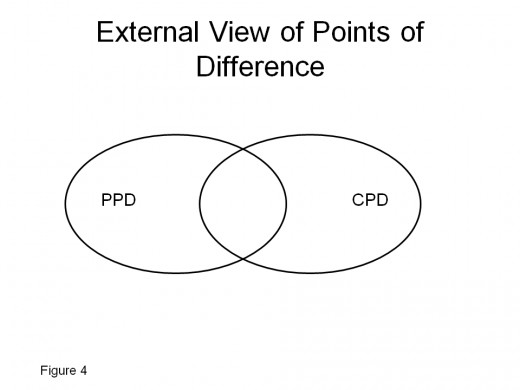
Before a person can begin to accept CPD they have to get past the values judgments associated with PPD. It will require people to move out of their comfort zone when dealing with people who are different themselves. The reason why an organization would want to move their organization beyond PPD is to capitalize on the thought diversity that exists with CPD. When the organization is making that transition, many of the human relations issues associated with PDD start to fall off. This is not to say that an organization that has embraced the foundational concepts of diversity and has moved to dealing with CPD will not have issues of discrimination or harassment. Traditional forms of discrimination will still happen, because not all employees will mature at the same pace. However, the organization will be in a better position to deal with the problems. In addition, there will be new forms of discrimination that the employer will have to address.
An organization has the challenge of knowing how to guide their employees to the next dimension of understanding. Too many organizations are trying to transition their organizations prematurely to the next dimension, which can adversely hinder their efforts. There are two reasons for this line of thinking. First of all, they try to count CPD influencers the same way they counted PPD characteristics. There has been a debate in many companies as to what constitutes a diverse hire. They want to include in the formulation, educational background and other CPD influencers, but this will not work in the manner that they expect. Most CPD are not measurable in the same manner as PPDs are. The problem is weighting how the CPDs affect a person’s perceptions. The second problem of moving too fast lies with an understanding of how people come to accept points of difference.
The challenge each person has while trying to grasp the idea of diversity is the acceptance of points of difference. The more points of perceived difference a person has to deal with the harder it becomes for them to accept the other person(s).[3] For example, in job groups that have been traditionally white male, it has historically been a challenge to introduce white female or males of other ethnicity or color into the group because their physical presence represents a readily apparent challenge and change to the status quo. The process becomes more difficult if the person representing other group(s) brings with them, for example, a different speech pattern. The different speech pattern in this example represents a second point of difference that has to be accepted. If a third point of difference is added to the mix, let us say physical limitations, then it becomes even more difficult for the person to be accepted into the group. With each point of difference, the acceptance rate[4] becomes more challenging and lengthy[5].
During a discrimination investigation, the EEO tech had a conversation with a female aircraft mechanic that is relevant to this discussion. She told the tech that when she first entered into the career field she had to be five times more proficient than the best male to be considered equal to the worst male mechanic. Over time,[6] she was able to overcome that informal ranking system to be placed on par with and eventually above her male counterparts. When she first entered the career field, she was careful to display only one point of difference she was adding to the mix. She had no choice about displaying this point of difference since being female in a traditionally male occupation was something that her co-workers noticed immediately. Once her group accepted that first point of difference she could begin to openly display other points of difference, making it easier for other women to follow behind her at that location.
Let me digress as a way of transitioning to the next main point. It is okay to recognize a person’s difference. Most people[7] will tell you that they want you to recognize them for who they are. After all, I am a white male and to say that I am not one is insane. In fact, to deny my whiteness or my maleness is to deny me access to a part of me. The same is true when I look at or interact with a person who is different then myself. To deny the difference means that I am trying to force fit that person into my concept of their being. This denial hinders any attempt at productive interaction. We, as a society, did go through a period where it was socially unacceptable to say what a person was. We tried to manipulate our speech so it was completely neutral. It is not a problem if people see me as a white male. The problem comes when another individual or organization places a value judgment (either positive or negative) based solely on those two aspects of my personhood. The value judgment should be placed upon what I bring to the organization.
Figure 5

Most diversity training courses end when they talk about the characteristics and influencers, which provides an incomplete picture. Organizations have to understand CPD and PPD as they relate to the four phases of understanding (Figure 5) that a person works through while negotiating the different phases of diversity awareness. As people move through the different phases, they are also able to move through the different dimensions. This paper is taking the time to describe each phase because people will often try to lump three of the four phases together. Each phase has a different meaning and causes different reactions to the environment. In addition, the way this paper is defining the terms may not be in line with common definitions.
Phase I is Intolerance; this is when person A is unable or unwilling to recognize other people, or practices. Ignorance often plays a major role in the maintenance and perpetuation of this phase. A point of fact is everyone resides in this phase at some point in their lives; the trick is to recognize it and move on. Discussions at this level are confrontational, with very little effective communication. The work environment tends to be hostile, but it can have a surface appearance of calm due to the exclusion of people identified as different and lack of effective honest communication.
Phase II is Tolerance; that is where person A recognizes other people, beliefs, or practices. In this phase, people are not actively opposing or interfering with other people/practices. There are a few attempts at understanding, but the main focus of this phase is on co-existing. It is at this level that people can begin to work together and it leaves the door open for more communication and cooperation. This is the level of polite conversations and it is easy for old stereotypes to detract from the superficial calm. The work environment at this phase is pleasant, as long as no one pushes an issue.
It must be understood that tolerance is only one-step, but to have lasting understanding a person must move beyond it. In the book Problems of Religious Diversity, describe the problem with tolerance as a final goal of human interaction.
To tolerate something (some action, behavior, or event) is to permit it to e what it is without interference or coercion. Toleration in this sense (there are others) carriers with it also the connotation of dislike or neutrality: you tolerate, or put up with, actions or events that you would prefer not to be occurring, or in whose occurrence you have no interest; you don’t tolerate something you like or are happy about—or at least it sounds odd to say that you do.[8]
Phase III is Acceptance; this is where the point of difference encountered is seen for what it is and is evaluated on its merits, versus making a value judgment. It is possible to have acceptance of people or practices without agreement. The true strength of an organization is not in how well they agree with each other but rather how they disagree with each other. Acceptance begins with the recognition of the difference and where that difference comes from. In this phase, there is an active attempt at understanding. Acceptance is the ability to get beyond surface disagreements.
At this level, the effective sharing of ideas begins. It is an environment where difference of thought processes can be brought to the table. However, the art of effective communicating or disagreeing with the difference has not been fine tuned, so heated discussion happens more often. This is where some managers become uncomfortable, because now they have to deal with confrontation and it has the appearance of being disruptive to the work environment.
Phase IV is Agreement; agreement is coming to an understanding between the parties on how to effectively work together. More often than not, the working arrangement that the parties agree on is a mutation that has grown out of the opposing ideas. Sometimes the agreement reached is not to agree. This type of non-agreement is a progressive interaction, because the disagreements at this stage are not based on superficial differences.
In the agreement phase, the participants are actively looking for points of commonality between members of the different groups while they are looking for ways to capitalize on their differences. There also exists a level of mutual understanding and some level of support. This is where the organizational members have learned how to effectively voice their points of difference so they can be heard. The end goal of diversity management is not about the creation of a Utopian society, where everyone likes everyone. There will always be a level of tension that left unmanaged the organization[9] will regress to lower phases of understanding.
Like everything else we have explored in this paper, the movement through the phases of understanding is not linear. If a person reaches acceptance with one person it does not mean that they will reach the same level of understanding with the next person they encounter.
Figure 6
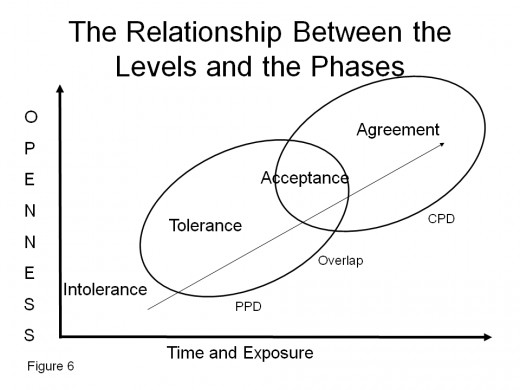
Relationship between Phases and Dimensions (Figure 6)
PPD and CPD are concerned with the make up of people, how they come to know themselves in relation to the world. The four phases are the process that people work through to understand other people. As a person moves through the phases only then will they be able to appreciate the differences that people bring. A person, who is intolerant, using my definition, does not recognize “others” as human and their understanding of the other does not exist on either level. One might ask here, “Don’t they have to recognize a race or a gender to be intolerant of that race or gender?” The answer is, no, their intolerance is fueled by their ignorance of their particular blind spot and they are looking at the other person as less than human. When a person learns to be tolerant, they are dealing with the PPD.
Once they have made this move to acceptance then they can begin to appreciate the CPD dimensions that a person has to offer. The advantage to an organization’s push to an understanding of CPD is simple. That is where the true value of diversity comes from. CPD are the life experiences that shape the individual, which allows them to look at the world differently. This is what gives the organization the opportunity to have the insight to what their customers, clients, and competitors’ needs are.
Notice I have placed the ideas of Phase, PPD and CPD on a graph. The x-axis is Time and Exposure, while the y-axis is Openness or Willingness. Time and Exposure interact between different groups of people. This exposure does not necessarily mean a physical interaction between people in the beginning. It can start out as research, study, and exposure to cultural artifacts or events. For true progression there will eventually have to be physical interaction and discourse. Physical interaction and discourse are the best teachers of culture. Openness/Willingness means simply that you as an individual have decided to let yourself acknowledge that difference exists and that difference does not have to equate into evil or wrong.
The two axes have to work in conjunction with each other to have any effect. You can have all the exposure to a different culture but without an openness to learn you will not progress past intolerance. In addition, you could be open to all the possibilities that a new culture could bring to your life, but without time and exposure the picture of the other becomes distorted and you too will stay in the intolerance phase or you might be able to progress to the lower end of tolerance.
Effectively Managing Disagreement
To evolve to the acceptance level there will be multiple points of difference that each person will have to work through. On an individual level how do you disagree with a person that you have multiple point of difference with but still move forward? Here are a couple of suggestions. A word of caution these are critical steps, and they are very difficult to continuously implement, but the effort to do so will be well worth it.
1. Listen: Listening is the foundation of all human relations. In the diversity scenario that is being used the term listening is any means by which a person translates information. Many people believe that they are good listeners, when in fact most people cannot hear anything beyond their own localized language. Through our CPD, people have developed a system of filters that are activated or deactivated when buzzwords enter into the discourse. The art of good listening is being able to recognize within yourself what your filters are and make adjustments accordingly. A simple trick to ensure that you are listening to what is being said to echo back what you heard. I am constantly surprised how people interpret things that I have said. The only way that I know if the message was received in the manner that I intended is for the receiver to repeat back what they heard and what that means to them.
2. Revalidate: Information that is not revisited for validity will stagnate and be cumbersome. A clear indication that information or process needs to be revalidated is when the organizational answer to a proposed change to traditional process is, “This is the way we have always done it.” When revalidating information remember:
You are not always right. There are many barriers that may prevent people from seeing that the current popular point of view is not correct; this paper is going to take a look at only three. A) Ego: The ego is the part of the brain that just does not want to admit that it might be wrong. While ego is a substantial barrier to paradigm, it is not the only barrier to be concerned with. B) Comfort Zone: Comfort with the current knowledge level tends to make people uneasy about new ideas. The new ideas represent the unknown; so even in bad situations some people will be reluctant to change. C) Organizational Environment: In some organizational environments, people are forced to act as if they are always right. Any perception of a lack of knowledge can be seen as a career killer.
Traditions are not always wrong; You may end up revalidating the traditional norms of the organization during the course of the recycle phase. Do not be surprised if the current way of doing business has validity to it.
3. Evaluate: Seriously investigate the reason for the conflict to find out what is creating tension and conflict within the organization. Is the source of the conflict a personal preference or a point of necessity? If the tension is caused by conflicting personal preferences, then you have to compare the preference against performance or end result. If it is cause by a point of necessity then it becomes your responsibility to communicate the reasons for the necessity.
4. Keep the organizational mission in mind. Many points of disagreement can be resolved by keeping this in mind. It helps to shift the focus of the disagreement from a point of confrontation to a point of commonality. When employees feel disassociated from the organization then it becomes harder for them to work towards a common goal or end. The energy and drive to proactively address issues will not be there.
5. Voicing Opposition. Learn how to communicate opposing ideas so that people can hear them is truly an art form. Just like listening, most people think they are effective communicators, when in fact they are not. Everyone processes data differently so what is effective for one person may not work for another. This is a key concept, no matter how great an idea is, if no one is listening it is an ineffective idea. It takes all your knowledge about people and culture to be continuously heard.
Figure 7
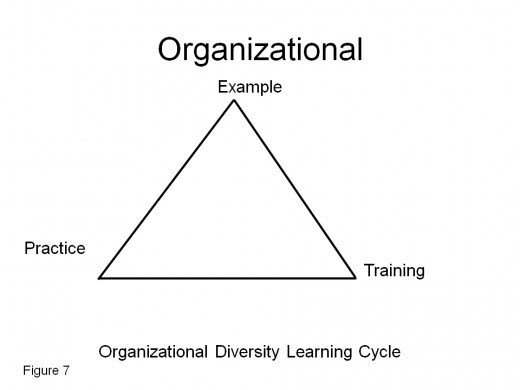
Organizational Diversity Learning Cycle
The personal model has to be matched to an organizational model to show how to move an organization and employees through the different dimensions of diversity appreciation and phases of recognition and interaction. The model is a simple one of: Example – Educate – Practice. This is a continuous process and, once started, each leg will feed off the other. But, it all starts with organizational leadership.
Example: The organizational leadership has to set the example for others to follow. Too often diversity efforts fall flat because the organizational leadership is not committed to the process. They will publicly pay lip service to the importance of diversity because that is what the Marketing, Human Resources and Legal Departments told them to do. In many organizations, the workforce can see physical diversity does not apply to all levels of the organization. The intent is to make diversity a part of the organizational culture. To do this, the members throughout all echelons of the organization have to be able to see them-selves reflected though out the organization in more than just a token manner. At the same time, they have to be able to see that people are allowed to bring different ideas to the table, without risk. A manager has to be able to show workers that, while ideas and processes will not always be incorporated, they can always bring them to the table.
Educate: There must be a continuous educational process for employees. The reason for the continuous process is simple the dynamics of human interaction are fluid and so the information has to be fluid. A one-time diversity-training course with no valid follow up action will only reinforce the idea that diversity management is just the latest in a never-ending string of management fads that will soon be fading into the background with no real impact on the workplace. Continuous and active steps are required to infuse the diversity beliefs into the DNA of the organization. In addition, people tend to have very short memories; it is easy to backslide if people cannot remember why the organization is taking a course of action. After the initial introduction, diversity must be incorporated into the fabric of organizational culture. It has to make the transition from being a human resources program to being an operational imperative.
To help make the transition from a program to an operational imperative the training should not be limited to just awareness training. In fact if that is where the training ends then the organization is not serious about making the transition. Training is a continuous process and should be geared towards the different levels of an organization. For example, managers and supervisors need to know how to lead their respective areas and mentor their employees to succeed, while employees need to know strategies for effectively bringing their ideas to the table so people will listen to them.
Practice: Because human interaction is so fluid and dynamic it will take time and practice. There are going to be mistakes and some people are not going to be satisfied. However, honest efforts are usually met with understanding because most people will be willing to work through the missteps.
Conclusion
In this paper, I have described a two-level model of diversity and the four phases of understanding people and organizations must go through in order to effectively engage a diverse workplace. I have also given concrete suggestions for effectively managing disagreement. Finally, I have sketched a learning cycle that organizations can use to move progressively and effectively towards a dynamic and diverse environment. The knowledge of the source of possible tension combined with an understanding of how we deal with difference will provide the energy necessary to complete the paradigm shift toward a dynamic, productive, diverse environment.
FOOTNOTES
[1] I am using the term “colored faces” metaphorically to mean all the different dimensions of physical diversity
[2] http://www.brainyquote.com/quotes/authors/g/george_s_patton.html
[3] Tolerance or acceptance does not have to mean agreement. (I will explain this concept later.)
[4] The time it takes to be accepted as a part of the group.
[5] The acceptance rate is neither equal nor consistent between individuals
[6] When I meet her, she was in her 15th year in the career field.
[7] Note that I did say “most people” and not “all people”.
[8] Griffiths, Paul J. Problems of Religious Diversity. Pg 101
[9] Organization: Country, business, or community
© 2011 Mark Monroe


